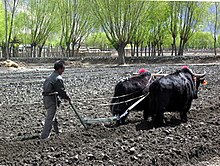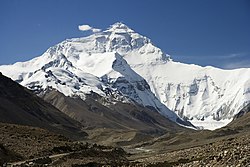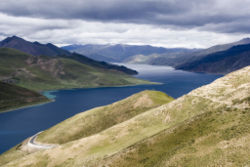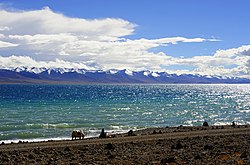This article is about the administrative region of China. For the ethno-cultural region, see
Tibet. For other uses, see
Tibet (disambiguation).
Tibet Autonomous Region
Xizang Autonomous Region
西藏自治区 |
|---|
| Autonomous region |
| Name transcription(s) |
|---|
| • Chinese | 西藏自治区 (Xīzàng Zìzhìqū) |
|---|
| • Abbreviation | 藏 (pinyin: Zàng) |
|---|
| • Tibetan script | བོད་རང་སྐྱོང་ལྗོངས། |
|---|
| • Wylie transliteration | bod rang skyong ljongs |
|---|
| • official transcription (PRC) | Poi Ranggyong Jong |
|---|

Map showing the location of the Tibet Autonomous Region
|
| Named for | From word Tibat of disputed origin. |
|---|
Capital
(and largest city) | Lhasa |
|---|
| Divisions | 5 prefecture-level cities, 2prefectures, 6 districts, 68counties, 692 townships |
|---|
| Government |
|---|
| • Secretary | Chen Quanguo |
|---|
| • Chairman | Losang Jamcan |
|---|
| Area[1] |
|---|
| • Total | 1,228,400 km2(474,300 sq mi) |
|---|
| Area rank | 2nd |
|---|
| Population (December 2014)[2] |
|---|
| • Total | 3,180,000 |
|---|
| • Rank | 32nd |
|---|
| • Density | 2.59/km2 (6.7/sq mi) |
|---|
| • Density rank | 33rd |
|---|
| Demographics |
|---|
| • Ethnic composition | 90% Tibetan
|
|---|
| • Languages and dialects | Tibetan, Mandarin Chinese |
|---|
| ISO 3166 code | CN-54 |
|---|
| GDP (2014) | CNY 92.1 billion
US$ 15 billion (32nd) |
|---|
| - per capita | CNY 29,279
US$ 4,766 (28th) |
|---|
| HDI (2010) | 0.569[3] (medium) (31st) |
|---|
| Website | www.Xizang.gov.cn |
|---|
Within China, Tibet is identified as an Autonomous Region. The current borders of Tibet were generally established in the 18th century
[4] and include about half of
ethno-cultural Tibet. The Tibet Autonomous Region is the second-largest
province-level division of China by area, spanning over 1,200,000 square kilometres (460,000 sq mi), after
Xinjiang, and mostly due to its harsh and rugged terrain, is the least densely populated provincial-level division of the PRC.
History[edit]
In 1950, the People's Liberation Army defeated the Tibetan army in a
battle fought near the city of
Chamdo. In 1951, the Tibetan representatives signed a
17-point agreement with the Chinese
Central People's Government affirming China's
sovereignty over Tibet and the
incorporation of Tibet. The agreement was ratified in Lhasa a few months later.
[9][10] Although the 17-point agreement had provided for an autonomous administration led by the
Dalai Lama, a "Preparatory Committee for the Autonomous Region of Tibet" (PCART) was established in 1955 to create a parallel system of administration along Communist lines. The Dalai Lama fled to India in 1959 and renounced the 17-point agreement. Tibet Autonomous Region
was established in 1965, thus making Tibet an administrative division on the same legal footing as a Chinese province.
Geography[edit]
The Tibet Autonomous Region is located on the
Tibetan Plateau, the highest region on earth. In northern Tibet elevations reach an average of over 4,572 metres (15,000 ft).
Mount Everest is located on Tibet's border with
Nepal.
Physically, the Tibet AR may be divided into two parts, the "lakes region" in the west and north-west, and the "river region", which spreads out on three sides of the former on the east, south, and west. Both regions receive limited amounts of rainfall as they lie in the
rain shadow of the
Himalayas, however the region names are useful in contrasting their
hydrological structures, and also in contrasting their different cultural uses which is
nomadic in the lake region and
agricultural in the river region.
[11] On the south the Tibet AR is bounded by the Himalayas, and on the north by a broad mountain system. The system at no point narrows to a single range; generally there are three or four across its breadth. As a whole the system forms the watershed between rivers flowing to the Indian Ocean − the
Indus,
Brahmaputra and
Salween and its tributaries − and the streams flowing into the undrained salt lakes to the north.
The lake region extends from the
Pangong Tso Lake in
Ladakh,
Lake Rakshastal,
Yamdrok Lake and
Lake Manasarovar near the source of the
Indus River, to the sources of the
Salween, the
Mekong and the
Yangtze. Other lakes include
Dagze Co,
Namtso, and
Pagsum Co. The lake region is a wind-swept Alpine grassland. This region is called the
Chang Tang (Byang sang) or 'Northern Plateau' by the people of Tibet. It is some 1,100 km (680 mi) broad, and covers an area about equal to that of France. Due to its great distance from the ocean it is extremely arid and possesses no river outlet. The mountain ranges are spread out, rounded, disconnected, separated by relatively flat valleys.
The Tibet AR is dotted over with large and small lakes, generally salt or
alkaline, and intersected by streams. Due to the presence of
discontinuous permafrost over the Chang Tang, the soil is boggy and covered with tussocks of grass, thus resembling the Siberian
tundra. Salt and fresh-water lakes are intermingled. The lakes are generally without outlet, or have only a small
effluent. The deposits consist of
soda,
potash,
borax and common
salt. The lake region is noted for a vast number of
hot springs, which are widely distributed between the Himalaya and 34° N, but are most numerous to the west of Tengri Nor (north-west of Lhasa). So intense is the cold in this part of Tibet that these springs are sometimes represented by columns of ice, the nearly boiling water having frozen in the act of ejection.
The river region is characterised by fertile mountain valleys and includes the
Yarlung Tsangpo River (the upper courses of the
Brahmaputra) and its major tributary, the
Nyang River, the
Salween, the Yangtze, the
Mekong, and the
Yellow River. The
Yarlung Tsangpo Canyon, formed by a horseshoe bend in the river where it flows around
Namcha Barwa, is the deepest, and possibly longest canyon in the world.
[12] Among the mountains there are many narrow valleys. The valleys of
Lhasa,
Xigazê,
Gyantse and the Brahmaputra are free from permafrost, covered with good soil and groves of trees, well irrigated, and richly cultivated.
The
South Tibet Valley is formed by the Yarlung Tsangpo River during its middle reaches, where it travels from west to east. The valley is approximately 1200 kilometres long and 300 kilometres wide. The valley descends from 4500 metres above sea level to 2800 metres. The mountains on either side of the valley are usually around 5000 metres high.
[13][14] Lakes here include
Lake Paikuand
Lake Puma Yumco.
Government[edit]
The Tibet Autonomous Region is a province-level entity of the People's Republic of China. It is governed by a People's Government, led by a Chairman. In practice, however, the Chairman is subordinate to the branch secretary of the
Communist Party of China. As a matter of convention, the Chairman has almost always been an ethnic Tibetan, while the party secretary has almost always been a non-Tibetan. The current Chairman is
Losang Jamcan and the current party secretary is
Chen Quanguo.
[15] India’s request, to open a consulate in Lhasa, capital of Tibet has been rejected by Beijing. Beijing, instead has offered Chengdu, the capital of Sichuan province. According to diplomatic sources familiar with the developments, the Chinese don’t want more consulates in Lhasa, where only Nepal has one.
[16]
Administrative divisions[edit]
Demography[edit]
| Historical population |
|---|
| Year | Pop. | ±% |
|---|
| 1912[21] | 1,160,000 | — |
|---|
| 1928[22] | 372,000 | −67.9% |
|---|
| 1936-37[23] | 372,000 | +0.0% |
|---|
| 1947[24] | 1,000,000 | +168.8% |
|---|
| 1954[25] | 1,273,969 | +27.4% |
|---|
| 1964[26] | 1,251,225 | −1.8% |
|---|
| 1982[27] | 1,892,393 | +51.2% |
|---|
| 1990[28] | 2,196,010 | +16.0% |
|---|
| 2000[29] | 2,616,329 | +19.1% |
|---|
| 2010[30] | 3,002,166 | +14.7% |
|---|
| Xikang Province / Chuanbian SAR was established in 1923 from parts ofTibet / Lifan Yuan; dissolved in 1955 and parts were incorporated into Tibet AR. |
With an average of only two people per square kilometer, Tibet has the lowest
population density among any of the Chinese province-level administrative regions, mostly due to its harsh and rugged terrain.
[31]
Historically, the population of Tibet consisted of primarily ethnic
Tibetans. According to tradition the original ancestors of the Tibetan people, as represented by the six red bands in the Tibetan flag, are: the Se, Mu, Dong, Tong, Dru and Ra. Other traditional ethnic groups with significant population or with the majority of the ethnic group reside in Tibet include
Bai people,
Blang,
Bonan,
Dongxiang,
Han,
Hui people,
Lhoba,
Lisu people,
Miao,
Mongols,
Monguor (Tu people),
Menba (Monpa),
Mosuo,
Nakhi,
Qiang,
Nu people,
Pumi,
Salar, and
Yi people.
According to
Encyclopædia Britannica Eleventh Edition published between 1910–1911, total population of Tibetan capital of Lhasa, including the lamas in the city and vicinity, was about 30,000, and the permanent population also included Chinese families (about 2,000).
[35]
Some ethnic Tibetans claim that, with the 2006 completion of the
Qingzang Railway connecting the TAR to Qinghai Province, there has been an "acceleration" of Han migration into the region.
[38] The Central Tibetan Administration of the Dalai Lama claims that the PRC has actively swamped Tibet with migrants in order to alter Tibet's demographic makeup.
[39]
Religion[edit]
The main religion in Tibet has been
Buddhism since its outspread in the 8th century AD. Before the arrival of Buddhism, the main religion among Tibetans was an indigenous
shamanic and
animistic religion,
Bon, which now comprises a sizeable minority and which would later influence the formation of
Tibetan Buddhism.
According to estimates from the International Religious Freedom Report of 2012, most of Tibetans (who comprise 91% of the population of the Tibet Autonomous Region) are bound by Tibetan Buddhism, while a minority of 400,000 people (12.5% of the total population of the TAR) are bound to the native Bon or folk religions which share the image of
Confucius (
Tibetan:
Kongtse Trulgyi Gyalpo) with
Chinese religion, though in a different light.
[42][43] According to some reports, the government of China has been promoting the Bon religion linking it with
Confucianism.
[44]
Most of the
Han Chinese who reside in Tibet practice their native
Chinese folk religion (
Shendao 神道, "Way of the Gods"). There is a Guandi Temple of Lhasa (拉萨关帝庙) where the Chinese god of war
Guandi is identified with the cross-ethnic Chinese, Tibetan, Mongol and Manchu deity
Gesar. The temple is built according to both Chinese and Tibetan architecture. It was first erected in 1792 under the
Qing dynasty and renovated around 2013 after decades of disrepair.
[45][46]
There are four mosques in the Tibet Autonomous Region with approximately 4,000 to 5,000
Muslim adherents,
[40] although a 2010 Chinese survey found a higher proportion of 0.4%.
[41] There is a
Catholic church with 700 parishioners, which is located in the traditionally Catholic community of Yanjing in the east of the region.
[40]
Towns and villages in Tibet[edit]
"Comfortable Housing"[edit]
Beginning in 2006, 280,000 Tibetans who lived in traditional villages and as nomadic herdsmen have been forcefully relocated into villages and towns. In those areas new housing was built and existing houses were remodelled to serve a total of 2 million people. Those living in substandard housing were required to dismantle their houses and remodel them to government standards. Much of the expense was borne by the residents themselves often through bank loans. The
population transfer program, which was first implemented in
Qinghai where 300,000 nomads were resettled, is called "Comfortable Housing". which is part of the “Build a New Socialist Countryside” program. Its effect on Tibetan culture has been criticized by exiles and human rights groups.
[49] Finding employment is difficult for relocated persons who have only agrarian skills. Income shortfalls are made up for by government support programs.
[50] It was announced in 2011 that 20,000 Communist Party cadre were to be placed in the new towns.
[49]
Economy[edit]

Tibetan farmer ploughing a field with
yaks
The Tibetans traditionally depended upon agriculture for survival. Since the 1980s, however, other jobs such as taxi-driving and hotel retail work have become available in the wake of
Chinese economic reform. In 2011, Tibet's nominal
GDP topped 60.5 billion yuan (US$9.60 billion), nearly more than seven times as big as the 11.78 billion yuan (US$1.47 billion) in 2000. In the past five years, Tibet's annual GDP growth has averaged 12%.
[31]
While traditional agriculture and animal husbandry continue to lead the area's economy, in 2005 the
tertiary sector contributed more than half of its GDP growth, the first time it surpassed the area's primary industry.
[51][52] Rich reserves of natural resources and raw materials have yet to lead to the creation of a strong secondary sector, due in large part to the province's inhospitable terrain, low population density, an underdeveloped infrastructure and the high cost of extraction.
[31]
The collection of
caterpillar fungus (
Cordyceps sinensis, known in Tibetan as
Yartsa Gunbu) in late spring / early summer is in many areas the most important source of cash for rural households. It contributes an average of 40% to rural cash income and 8.5% to the TAR's GDP.
[53]
The re-opening of the
Nathu La pass (on southern Tibet's border with India) should facilitate Sino-Indian border trade and boost Tibet's economy.
[54]
In 2008, Chinese news media reported that the
per capita disposable incomes of urban and rural residents in Tibet averaged 12,482 yuan (US$1,798) and 3,176 yuan (US$457) respectively.
[55]
The
China Western Development policy was adopted in 2000 by the central government to boost economic development in western China, including the Tibet Autonomous Region.
Tourism[edit]
Foreign tourists were first permitted to visit the Tibet Autonomous Region in the 1980s. While the main attraction is the
Potala Palacein
Lhasa, there are many other popular tourist destinations including the
Jokhang Temple,
Namtso Lake, and
Tashilhunpo Monastery.
[56] Nonetheless, tourism in Tibet is still restricted for non-Chinese passport holders and Taiwan citizens, and presently the only way for foreigners to enter is via Tibet Entry Permit. The permit can only be obtained through a travel agency in Tibet, and travel in Tibet must be arranged in a group tour, in which the group must be accompanied by a licensed tour guide at all times. Those traveling into Tibet must specify every location they want to travel within the TAR, and thus cannot travel anywhere not specified in the application. Before entering on a train, plane, or road leading into Tibet, anyone without a Chinese passport must present the Tibet Entry Permit, or they will otherwise be denied entry. Even people coming to Tibet from Nepal must have arranged for the entry permit ahead of time. People barred from obtaining the permit are journalists, diplomats, professional media photographers, and government officials.
[57]
Transport[edit]
Airports[edit]
Nagqu Dagring Airport is expected to become the world's highest altitude airport by 2014 at 4,436 meters above sea level.
[61]
Railway[edit]
The
Qinghai–Tibet Railway from
Golmud to Lhasa was completed on 12 October 2005. It opened to regular trial service on 1 July 2006. Five pairs of passenger trains run between Golmud and Lhasa, with connections onward to Beijing, Chengdu, Chongqing, Guangzhou, Shanghai, Xining and Lanzhou. The line includes the
Tanggula Pass, which, at 5,072 m (16,640 ft) above sea level, is the world's highest railway.
The construction of first section of the
Sichuan–Tibet Railway from Lhasa to
Nyingchi. Construction work is expected to start in November 2014, and to take 7 years.
[62]













